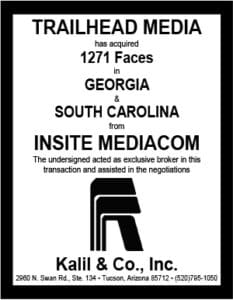By Richard Hamlin and Marnie Christine Cody, Hamlin|Cody
In the same way that a utility company has an easement to run cables or power lines across a private property, a company or individual can permit the construction and display of a billboard on a property. In the billboard industry, a permanent easement is typically bought from a property owner for a lump sum payment.

The easement grants the billboard company perpetual use of a portion of the property to locate the structure, access the sign, run electricity to the structure, and protect the sign’s visibility from the roadway.
Creating an easement for billboard purposes can make sense for both landowners and billboard companies. Here are 10 must-haves to include in your out-of-home easement agreement.
1. Property Description
A full legal description is best. When this is not available an address and Tax Assessor’s Parcel Number should be used.
2. Easement Area Description
It is important to be as specific as possible about where the easement is on the property and how big it is. The easement should be drawn, to scale, on a property map and described in detail. A precise description of the location by a surveyor will help to reduce disputes about where the billboard can be placed. (On the other hand, a less precise description can allow more flexibility in placing the sign. See the last bullet point under Point 6 – Covenant not to Disturb.)
3. Term
Easements should specify whether they are perpetual or for a limited duration.
4. Consideration

In the easement, the consideration (compensation) and the method of payment should be specified. Although usually a lump sum, any type of consideration can be valid.
5. Maintenance
The easement should specify who is responsible for premises maintenance. Typically, the landlord is responsible for maintaining the property outside the easement borders, and the billboard company is responsible for the billboard.
6. Covenant Not to Disturb
The easement should have language which allows the billboard company to:
- Access the billboard;
- Bring electricity to the billboard to permit night lighting;
- Install, repair and maintain the billboard;
- Prohibit the grantor (seller of the easement) from planting vegetation or building structures which obstruct the view of the billboard. This should include restrictions on adjacent property owned or controlled by the grantor.
- Allow the billboard company to move the billboard if part of the property is taken by eminent domain, or if view of the sign from the street is blocked.
7. Insurance
Any insurance obligations must be clearly stated in the easement agreement. Most landlords will want evidence that the billboard company has liability insurance.
8. Property Taxes
In California, a billboard is not subject to real estate tax. The typical support column for a modern billboard usually occupies less than one-half of one percent of the property area. In an easement agreement, the billboard company should pay any personal property tax assessed against the billboard. The property owner should pay the real property taxes.
9. Liability Indemnification
Typically each party to an easement agreement will agree to compensate the other party for loss or liability caused by the opposite party.
10. Defaults and Remedies
Unlike a lease, an easement grants a permanent interest in land. If the purchase price is paid in a lump sum, it should be done through an escrow. If either the grantor or the billboard owner breaches the easement, the injured party will need a court order to enforce the terms. An attorney-fees clause can require the losing party to pay the winning party’s attorney fees. At the same time, fights over attorney fees might prolong litigation. One solution would be to limit the maximum amount of attorney fees that a court can award.
[wpforms id=”9787″]
Paid Advertisement

















